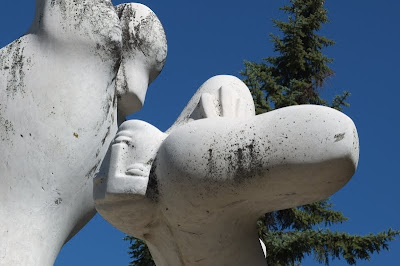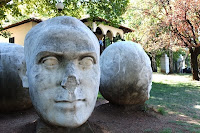Topola and Oplenac











 These pictures were taken during our last day-trip from Belgrade and the day before I was to fly back home. We had originally planned to drive with Miki to Avala, but he offered to drive us to Topola instead. Topola is the town where Karadjordje, the leader of the First Serbian Uprising against the Turks (1804), lived with his family before he had to go into exile. Oplenac hill is a complex which includes the amazing Crkva Svetog Djordja (church of Saint George), the building of which was planned by King Peter the First before WWI. This church is covered in mosaics, made from Murano glass in more than 35000 shades, which are copies of famous frescoes from monasteries in Serbia and Kosovo. It is a mausoleum where many members of the Karadjordjević family are buried. The site and the church are spectacular.
These pictures were taken during our last day-trip from Belgrade and the day before I was to fly back home. We had originally planned to drive with Miki to Avala, but he offered to drive us to Topola instead. Topola is the town where Karadjordje, the leader of the First Serbian Uprising against the Turks (1804), lived with his family before he had to go into exile. Oplenac hill is a complex which includes the amazing Crkva Svetog Djordja (church of Saint George), the building of which was planned by King Peter the First before WWI. This church is covered in mosaics, made from Murano glass in more than 35000 shades, which are copies of famous frescoes from monasteries in Serbia and Kosovo. It is a mausoleum where many members of the Karadjordjević family are buried. The site and the church are spectacular.
 Later that day we visited a small museum in Topola which used to be a Museum of the People's Liberation Struggle (1941-1945) but is now dedicated to the works of a local painter. The only remnants of this museum's former life is the beautiful sculptures in the museum garden depicting local WWII martyrs and famous local Partisans. The large marble heads are of four national heroes: Milan Blagojević, Milić Radovanović, Darinka Radović, and Sofija Ristić. They are by the sculptor Milija Glisić.
Later that day we visited a small museum in Topola which used to be a Museum of the People's Liberation Struggle (1941-1945) but is now dedicated to the works of a local painter. The only remnants of this museum's former life is the beautiful sculptures in the museum garden depicting local WWII martyrs and famous local Partisans. The large marble heads are of four national heroes: Milan Blagojević, Milić Radovanović, Darinka Radović, and Sofija Ristić. They are by the sculptor Milija Glisić.  The memorial to the mothers and daughters of Šumadija is by Ante Gržetić. It was originally conceived as a memorial to the national hero Darinka Radović and her two daughters Radmila and Stanka, who, according to my guide on Topola and Oplenac by M. Nedeljković published in 1989, were slaughtered by chetniks in 1943. Incredibly enough, the web page on Topola of the National Tourism Organization of Serbia makes no mention of any of these people. It however recommends to the visitor of Topola a “pampering body treatment at the Bukovicka Banja (spa) near Arandjelovac.”
The memorial to the mothers and daughters of Šumadija is by Ante Gržetić. It was originally conceived as a memorial to the national hero Darinka Radović and her two daughters Radmila and Stanka, who, according to my guide on Topola and Oplenac by M. Nedeljković published in 1989, were slaughtered by chetniks in 1943. Incredibly enough, the web page on Topola of the National Tourism Organization of Serbia makes no mention of any of these people. It however recommends to the visitor of Topola a “pampering body treatment at the Bukovicka Banja (spa) near Arandjelovac.”











 These pictures were taken during our last day-trip from Belgrade and the day before I was to fly back home. We had originally planned to drive with Miki to Avala, but he offered to drive us to Topola instead. Topola is the town where Karadjordje, the leader of the First Serbian Uprising against the Turks (1804), lived with his family before he had to go into exile. Oplenac hill is a complex which includes the amazing Crkva Svetog Djordja (church of Saint George), the building of which was planned by King Peter the First before WWI. This church is covered in mosaics, made from Murano glass in more than 35000 shades, which are copies of famous frescoes from monasteries in Serbia and Kosovo. It is a mausoleum where many members of the Karadjordjević family are buried. The site and the church are spectacular.
These pictures were taken during our last day-trip from Belgrade and the day before I was to fly back home. We had originally planned to drive with Miki to Avala, but he offered to drive us to Topola instead. Topola is the town where Karadjordje, the leader of the First Serbian Uprising against the Turks (1804), lived with his family before he had to go into exile. Oplenac hill is a complex which includes the amazing Crkva Svetog Djordja (church of Saint George), the building of which was planned by King Peter the First before WWI. This church is covered in mosaics, made from Murano glass in more than 35000 shades, which are copies of famous frescoes from monasteries in Serbia and Kosovo. It is a mausoleum where many members of the Karadjordjević family are buried. The site and the church are spectacular. Later that day we visited a small museum in Topola which used to be a Museum of the People's Liberation Struggle (1941-1945) but is now dedicated to the works of a local painter. The only remnants of this museum's former life is the beautiful sculptures in the museum garden depicting local WWII martyrs and famous local Partisans. The large marble heads are of four national heroes: Milan Blagojević, Milić Radovanović, Darinka Radović, and Sofija Ristić. They are by the sculptor Milija Glisić.
Later that day we visited a small museum in Topola which used to be a Museum of the People's Liberation Struggle (1941-1945) but is now dedicated to the works of a local painter. The only remnants of this museum's former life is the beautiful sculptures in the museum garden depicting local WWII martyrs and famous local Partisans. The large marble heads are of four national heroes: Milan Blagojević, Milić Radovanović, Darinka Radović, and Sofija Ristić. They are by the sculptor Milija Glisić.  The memorial to the mothers and daughters of Šumadija is by Ante Gržetić. It was originally conceived as a memorial to the national hero Darinka Radović and her two daughters Radmila and Stanka, who, according to my guide on Topola and Oplenac by M. Nedeljković published in 1989, were slaughtered by chetniks in 1943. Incredibly enough, the web page on Topola of the National Tourism Organization of Serbia makes no mention of any of these people. It however recommends to the visitor of Topola a “pampering body treatment at the Bukovicka Banja (spa) near Arandjelovac.”
The memorial to the mothers and daughters of Šumadija is by Ante Gržetić. It was originally conceived as a memorial to the national hero Darinka Radović and her two daughters Radmila and Stanka, who, according to my guide on Topola and Oplenac by M. Nedeljković published in 1989, were slaughtered by chetniks in 1943. Incredibly enough, the web page on Topola of the National Tourism Organization of Serbia makes no mention of any of these people. It however recommends to the visitor of Topola a “pampering body treatment at the Bukovicka Banja (spa) near Arandjelovac.”
No comments:
Post a Comment